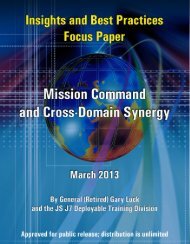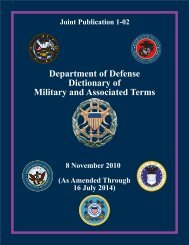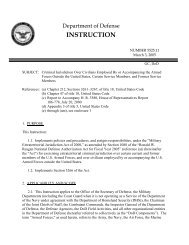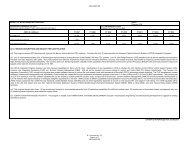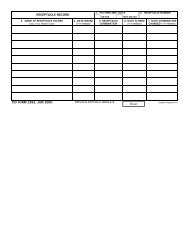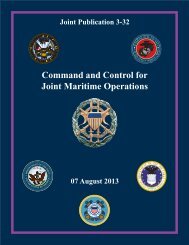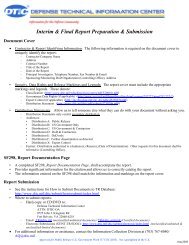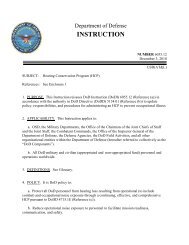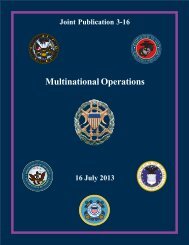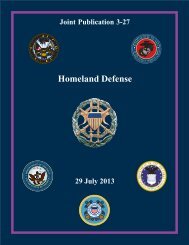JP 1, Doctrine for the Armed Forces of the United States - Defense ...
JP 1, Doctrine for the Armed Forces of the United States - Defense ...
JP 1, Doctrine for the Armed Forces of the United States - Defense ...
Create successful ePaper yourself
Turn your PDF publications into a flip-book with our unique Google optimized e-Paper software.
Joint Command and Control<br />
while conducting operations. Appropriate application <strong>of</strong> <strong>the</strong> command relationships<br />
discussed previously in Section A will help ensure that <strong>the</strong> requisite amount <strong>of</strong> control is<br />
applied while enabling sufficient latitude <strong>for</strong> decentralized execution. Additionally,<br />
commander to staff and staff to staff relationships must be developed through training to<br />
promote <strong>the</strong> understanding <strong>of</strong> all regarding <strong>the</strong> direction and/or support required.<br />
(2) Mission command is <strong>the</strong> conduct <strong>of</strong> military operations through decentralized<br />
execution based upon mission-type orders. It empowers individuals to exercise judgment in<br />
how <strong>the</strong>y carry out <strong>the</strong>ir assigned tasks and it exploits <strong>the</strong> human element in joint operations,<br />
emphasizing trust, <strong>for</strong>ce <strong>of</strong> will, initiative, judgment, and creativity. Successful mission<br />
command demands that subordinate leaders at all echelons exercise disciplined initiative and<br />
act aggressively and independently to accomplish <strong>the</strong> mission. They focus <strong>the</strong>ir orders on<br />
<strong>the</strong> purpose <strong>of</strong> <strong>the</strong> operation ra<strong>the</strong>r than on <strong>the</strong> details <strong>of</strong> how to per<strong>for</strong>m assigned tasks.<br />
They delegate decisions to subordinates wherever possible, which minimizes detailed control<br />
and empowers subordinates’ initiative to make decisions based on understanding what <strong>the</strong><br />
commander wants ra<strong>the</strong>r than on constant communications. Essential to mission command<br />
is <strong>the</strong> thorough understanding <strong>of</strong> <strong>the</strong> commander’s intent at every level <strong>of</strong> command and a<br />
command climate <strong>of</strong> mutual trust and understanding.<br />
(3) In<strong>for</strong>mation Management and Knowledge Sharing. Control and appropriate<br />
sharing <strong>of</strong> in<strong>for</strong>mation is a prerequisite to maintaining effective C2. For a discussion <strong>of</strong><br />
in<strong>for</strong>mation management and knowledge sharing, see <strong>JP</strong> 3-0, Joint Operations, and <strong>JP</strong> 3-33,<br />
Joint Task Force Headquarters.<br />
(4) Communication. Because JFCs seek to minimize restrictive control measures<br />
and detailed instructions, <strong>the</strong>y must find effective and efficient ways to create cooperation<br />
and compliance. Commander’s intent fosters communication and understanding with all<br />
subordinates. This common understanding builds teamwork and mutual trust. Two joint C2<br />
constructs that ensure implicit communication are <strong>the</strong> commander’s intent and mission<br />
statement.<br />
(a) Commander’s intent represents a unifying idea that allows decentralized<br />
execution within centralized, overarching guidance. It is a clear and concise expression <strong>of</strong><br />
<strong>the</strong> purpose <strong>of</strong> <strong>the</strong> operation and <strong>the</strong> military end state. It provides focus to <strong>the</strong> staff and<br />
helps subordinate and supporting commanders take actions to achieve <strong>the</strong> military end state<br />
without fur<strong>the</strong>r orders, even when operations do not unfold as planned.<br />
(b) JFCs use mission-type orders to decentralize execution. Mission-type<br />
orders direct a subordinate to per<strong>for</strong>m a certain task without specifying how to accomplish it.<br />
Within <strong>the</strong>se orders, <strong>the</strong> actual mission statement should be a short sentence or paragraph<br />
that describes <strong>the</strong> organization’s essential task (or tasks) and purpose—a clear statement <strong>of</strong><br />
<strong>the</strong> action to be taken and <strong>the</strong> reason <strong>for</strong> doing so. The senior leaves <strong>the</strong> details <strong>of</strong> execution<br />
to <strong>the</strong> subordinate, allowing <strong>the</strong> freedom and <strong>the</strong> obligation to take whatever steps are<br />
necessary to deal with <strong>the</strong> changing situation while encouraging initiative at lower levels.<br />
(5) Timely Decision Making. With well-defined commander’s critical in<strong>for</strong>mation<br />
requirement, effective common operational picture and establishing clear objectives, <strong>the</strong> JFC<br />
V-15



